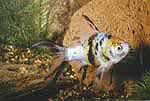 Fish may be beneficial to your health. Not just eating them, but watching them.
Fish may be beneficial to your health. Not just eating them, but watching them.
Three University of Pennsylvania researchers report that quietly watching fish swimming in a home aquarium eases stress, and may offer a means of treating high blood pressure.
The fish are the key, the researchers say. People who watch fish tanks with bubbles, pebbles and plants – but no fish – don’t benefit nearly as much.
“There is a sharp difference,” says ecologist Alan Beck, director of the university’s Center for the Interaction of Animals and Society. “Blood pressure drops with fishless fish tanks, but it doesn’t drop as much and it creeps back up faster. With fish in the tanks, you truly get relaxation.”
 Lowered blood pressure is one way to measure reduced stress. A number of ailments have been associated with high stress in daily life, including heart attacks, sleep disorders and some ulcers.Petting a dog or cat is a known stress-reducer. One study showed that survivors of heart attacks tended to live longer if they owned a dog.
Lowered blood pressure is one way to measure reduced stress. A number of ailments have been associated with high stress in daily life, including heart attacks, sleep disorders and some ulcers.Petting a dog or cat is a known stress-reducer. One study showed that survivors of heart attacks tended to live longer if they owned a dog.
Beck, psychiatrist Aaron H. Katcher and biologist Erika Friedmann decided to see if interaction with other animals produced similar results. They selected fish because they are such common pets. The Pet Information Bureau, sponsored by pet products companies, estimates that more than 10 million American homes have aquariums.
The researchers divided 100 paid volunteers into two groups. One at a time, they were put in a room and asked to read aloud – a proven way to induce stress – for one minute.
 Then they were left alone with a fish tank for 20 minutes. Half the time there were fish in the aquarium; half the time there were none. A device automatically recorded the volunteers’ blood pressure. Those who had fish to watch fared far better.
Then they were left alone with a fish tank for 20 minutes. Half the time there were fish in the aquarium; half the time there were none. A device automatically recorded the volunteers’ blood pressure. Those who had fish to watch fared far better.
The random selection of volunteers resulted in the participation of some who suffered from high blood pressure. “For them, the fish were much better than for a normal person, ” Beck says.
The Pennsylvania findings are part of a $12,000 project privately funded by the pet products industry.
WAITING ROOM FROM HELL
Do you sit on a cheap orange vinyl couch in your doctor’s waiting room thumbing morosely through a two-year-old travel and leisure magazine? Is the philodendron dying?
If so, you probably won’t follow your doctor’s advice, says Dr. Marvin Stone, a psychiatrist at the University of Texas Health Science Center in Houston. “If people have a negative vibration toward someone who’s giving them advice, “he says, “they won’t accept the advice.”
Stone has been cataloging common decoration faux pas among physicians: tattered, out of date periodicals; dying plants; and ambience suggestive of a Greyhound bus terminal. “Mismatched furniture,” he observes, “is almost universal and that furniture is as critical as what the doctor says.”
Stone suggests enhancing waiting rooms with plants, fish tanks and art. –G. Bear, Omni Magazine
WATCHING FISH CALMS PATIENTS
When I used to take my seven children to the pediatrician on Long Island, I didn’t realize that his huge fish tanks, which kept them fascinated during the wait for his attention, were and early example of what now carries the imposing name of “pet-facilitated therapy” (PFT).
I later had occasion to visit a psychiatrist (perhaps it was the seven kids who sent me there) and discovered that he, too, had a huge fish tank in his waiting room. At 75 bucks a shot, I suppose patients deserved a few amenities.
Now, New York’s Animal Medical Center has added a new facet to its PFT program. The New York Aquarium has donated a big fish tank to the Florence Nightingale Nursing Home, where 500 residents are said to find them absorbing.
According to Animal Medical Center scientists, recent studies have determined that watching fish calms people. Researcher Edith McBean will evaluate the effect of the fish on the older people during weekly visits to the home.
McBean cites a University of Pennsylvania study of 100 volunteers who were divided into two sections. Each group of 50 was put into a separate room, and then each person was asked to read aloud for one minute to produce stress.
Each group was then left alone with a fish tank for 20 minutes – one with an empty tank, the other with a full tank. The blood pressure of the volunteers watching fish dropped more than that of those who watched the empty tank.
[caldera_form id=”CF57858a3f4fb84″]

